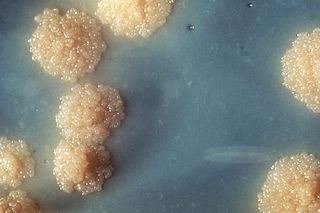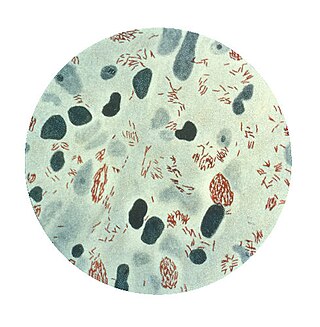
Mycobacterium tuberculosis, also known as Koch's bacillus, is a species of pathogenic bacteria in the family Mycobacteriaceae and the causative agent of tuberculosis. First discovered in 1882 by Robert Koch, M. tuberculosis has an unusual, waxy coating on its cell surface primarily due to the presence of mycolic acid. This coating makes the cells impervious to Gram staining, and as a result, M. tuberculosis can appear weakly Gram-positive. Acid-fast stains such as Ziehl–Neelsen, or fluorescent stains such as auramine are used instead to identify M. tuberculosis with a microscope. The physiology of M. tuberculosis is highly aerobic and requires high levels of oxygen. Primarily a pathogen of the mammalian respiratory system, it infects the lungs. The most frequently used diagnostic methods for tuberculosis are the tuberculin skin test, acid-fast stain, culture, and polymerase chain reaction.

Mycobacterium is a genus of over 190 species in the phylum Actinomycetota, assigned its own family, Mycobacteriaceae. This genus includes pathogens known to cause serious diseases in mammals, including tuberculosis and leprosy in humans. The Greek prefix myco- means 'fungus', alluding to this genus' mold-like colony surfaces. Since this genus has cell walls with Gram-positive and Gram-negative features, acid-fast staining is used to emphasize their resistance to acids, compared to other cell types.

Mycobacterium leprae, is one of the two species of bacteria that cause Hansen’s disease (leprosy), a chronic but curable infectious disease that damages the peripheral nerves and targets the skin, eyes, nose, and muscles.

Mycobacteroides abscessus is a species of rapidly growing, multidrug-resistant, nontuberculous mycobacteria that is a common soil and water contaminant. Although M. abscessus most commonly causes chronic lung infection and skin and soft tissue infection (SSTI), it can also cause infection in almost all human organs, mostly in patients with suppressed immune systems. Amongst NTM species responsible for disease, infection caused by M. abscessus complex are more difficult to treat due to antimicrobial drug resistance.
Mycobacterium caprae is a species of bacteria in the genus Mycobacterium and a member of the Mycobacterium tuberculosis complex. The species is named after the caprines, the organisms from which M. caprae was first isolated. Prior to 2003, the species was referred to as Mycobacterium tuberculosis subsp. caprae. It is also synonymous with the name Mycobacterium bovis subsp. caprae.
Mycobacterium celatum is a species of the phylum Actinomycetota, belonging to the genus Mycobacterium.

Cronobacter is a genus of Gram-negative, facultatively anaerobic, oxidase-negative, catalase-positive, rod-shaped bacteria of the family Enterobacteriaceae. Several Cronobacter species are desiccation resistant and persistent in dry products such as powdered infant formula. They are generally motile, reduce nitrate, use citrate, hydrolyze esculin and arginine, and are positive for L-ornithine decarboxylation. Acid is produced from D-glucose, D-sucrose, D-raffinose, D-melibiose, D-cellobiose, D-mannitol, D-mannose, L-rhamnose, L-arabinose, D-trehalose, galacturonate and D-maltose. Cronobacter spp. are also generally positive for acetoin production and negative for the methyl red test, indicating 2,3-butanediol rather than mixed acid fermentation. The type species of the genus Cronobacter is Cronobacter sakazakii comb. nov.
Mycobacterium lepromatosis is an aerobic, acid-fast bacillus (AFB), and the second known causative agent of Hansen's disease (leprosy). It was discovered in 2008. Analysis of the 16S rRNA gene confirms that the species is distinct from Mycobacterium leprae.
Mycobacterium saskatchewanense is a species of Mycobacterium.
Mycobacterium peregrinum is a species of Mycobacterium.
Mycobacterium novocastrense is a species of Mycobacterium.
Mycobacterium rhodesiae is a species of Mycobacterium.
Mycobacterium seoulense is a species of Mycobacterium.
Cytochrome P450, family 107, also known as CYP107, is a cytochrome P450 monooxygenase family in bacteria, found to be conserved and highly populated in Streptomyces and Bacillus species. The first gene identified in this family is Cytochrome P450 eryF (CYP107A1) from Saccharopolyspora erythraea. Many enzymes of this family are involved in the synthesis of macrolide antibiotics. The members of this family are widely distributed in Alphaproteobacteria, cyanobacterial, Mycobacterium, Bacillota, and Streptomyces species, which may be due to horizontal gene transfer driven by selection pressure.
Pluralibacter is a genus of Gram negative bacteria from the family of Enterobacteriaceae. The genus consists of two species, P. gergoviae and P. pyrinus. Both species were originally classified in the genus Enterobacter, but were reclassified into the novel genus Pluralibacter in 2013.
Pluralibacter pyrinus is a Gram-negative, motile, facultatively-anaerobic, rod-shaped bacterium. P. pyrinus is the causitive agent of brown leaf spot disease of pear trees.
Mycolicibacillus koreensis is a slow-growing, non-chromogenic species of Mycolicibacillus originally isolated from the sputum of a human patient. It grows at temperatures from 25–37 °C and is susceptible to quinolones. The genome of M. koreensis contains a tRNA array that contains a long non-coding RNA called GOLDD.
Mycolicibacillus parakoreensis is a slow-growing, non-chromogenic species of Mycolicibacillus originally isolated from the sputum of a human patient. It is susceptible to amikacin, clarithromycin, and rifampin.
"Mycolicibacter virginiensis" is a species of bacteria from the phylum Actinomycetota. It is susceptible to clarithromycin, ethambutol, rifabutin, and TMP-SMX. It has been isolated from cases of tenosynovitis, swine farm mud, bovine feces, sputum, and diseased dromedaries.
Mycolicibacter paraterrae is a species of bacteria from the phylum Actinomycetota that was first isolated from the sputum of a patient with an unspecified pulmonary infection. It forms orange colonies when grown in the dark and grows slowly at 25–37 °C. It has also been isolated from




